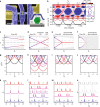Parity transitions in the superconducting ground state of hybrid InSb-Al Coulomb islands
- PMID: 30442935
- PMCID: PMC6237907
- DOI: 10.1038/s41467-018-07279-7
Parity transitions in the superconducting ground state of hybrid InSb-Al Coulomb islands
Abstract
The number of electrons in small metallic or semiconducting islands is quantised. When tunnelling is enabled via opaque barriers this number can change by an integer. In superconductors the addition is in units of two electron charges (2e), reflecting that the Cooper pair condensate must have an even parity. This ground state (GS) is foundational for all superconducting qubit devices. Here, we study a hybrid superconducting-semiconducting island and find three typical GS evolutions in a parallel magnetic field: a robust 2e-periodic even-parity GS, a transition to a 2e-periodic odd-parity GS, and a transition from a 2e- to a 1e-periodic GS. The 2e-periodic odd-parity GS persistent in gate-voltage occurs when a spin-resolved subgap state crosses zero energy. For our 1e-periodic GSs we explicitly show the origin being a single zero-energy state gapped from the continuum, i.e., compatible with an Andreev bound states stabilized at zero energy or the presence of Majorana zero modes.
Conflict of interest statement
The authors declare no competing interests.
Figures




References
-
- Das Sarma S, Freedman M, Nayak C. Majorana zero modes and topological quantum computation. Npj Quantum Inf. 2015;1:15001. doi: 10.1038/npjqi.2015.1. - DOI
-
- Kouwenhoven, L. P. et al. Electron transport in quantum dots. In Mesoscopic Electron Transport, Vol. 345, 105 (Springer, Dordrecht, 1997).
Publication types
LinkOut - more resources
Full Text Sources
Other Literature Sources
Molecular Biology Databases
Miscellaneous

